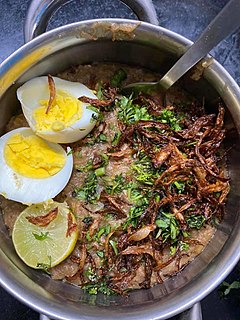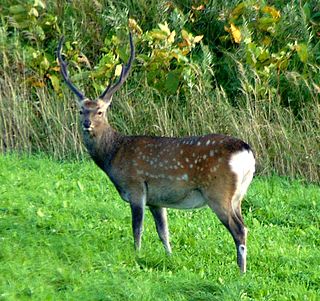The kailao is a cultural dance from the South Pacific country of Tonga. It originates from Wallis and Futuna.

Double ka meetha (also known as Shahi Tukra, is an Indian bread pudding sweet made of fried bread slices soaked in hot milk with spices, including saffron and cardamom. Double ka meetha is a dessert of Hyderabad. It is popular in Hyderabadi cuisine, served at weddings and parties. Double ka meetha refers to the milk bread, called "double roti" in the local Indian dialects because it swells up to almost double its original size after baking.

Hyderabadi biryani, also known as Hyderabadi dum biryani, is a style of biryani from Hyderabad, India made with basmati rice and meat. Originating in the kitchens of the Nizam of Hyderabad, it combines elements of Hyderabadi and Mughlai cuisines. Hyderabad biryani is a key dish in Hyderabadi cuisine and it is so famous that the dish is considered synonymous with the city of Hyderabad.

Hyderabadi is a variety of Dakhini Urdu, spoken in areas of the former Hyderabad State, corresponding to the Indian state of Telangana, the Marathwada region of Maharashtra and the Kalyana-Karnataka region of Karnataka.

Hyderabadi Muslims, also referred to as Hyderabadis are a community of Urdu-speaking Muslims, part of a larger ethnic group of Deccani people, from the area that used to be the princely state of Hyderabad in the regions of Marathwada, Telangana, and Kalyana-Karnataka.

Qubani ka meetha is an Indian dessert made from dried apricots. It is a part of Hyderabadi cuisine and is a common feature at Hyderabadi weddings.

Hyderabadi cuisine, also known as Deccani cuisine, is the native cooking style of the Hyderabad, India. The haute cuisine of Hyderabad began to develop after the foundation of the Bahmani Sultanate, and the Qutb Shahi dynasty centered in the city of Hyderabad promoted the native cuisine along with their own. Hyderabadi cuisine had become a princely legacy of the Nizams of Hyderabad as it began to further develop under their patronage.

Hyderabadi haleem is a type of haleem popular in the Indian city of Hyderabad. Haleem is a stew composed of meat, lentils, and pounded wheat made into a thick paste. It is originally an Arabic dish and was introduced to the Hyderabad State by the Chaush people during the rule of the Nizams. Local traditional spices helped a unique Hyderabadi haleem evolve, that became popular among the native Hyderabadis by the 20th century.

Lukhmi is a typical mince savoury or starter of the cuisine of Hyderabad, Telangana, India. It is a local variation of samosa. The snack's authentic preparation includes stuffing with mutton-mince kheema. It is a non-vegetarian derivative of the samosa although, unlike the latter, the lukhmi is shaped into a flat square patty.

Dahi chutney is strained dahi that is mixed into a chutney of mint and onions, originating from the Indian subcontinent. It is popular in South India and is a side dish along with Mirchi ka salan for the popular Hyderabadi biryani.

Mirchi ka salan, or curried chilli peppers, is a popular chilli and peanut curry of Hyderabad, Telangana, India that usually accompanies Hyderabadi biryani alongside dahi chutney. The dish contains green chilli peppers, peanuts, sesame seeds, dry coconut, cumin seeds, ginger and garlic paste, turmeric powder, bay leaf, and thick tamarind juice.
Nawab Mehboob Alam Khan is an Indian food connoisseur and culinary expert of Hyderabadi cuisine. He has restored many lost recipes of the Hyderabadi tradition.

Iatmul is the language of the Iatmul people, spoken around the Sepik River in the East Sepik Province, northern Papua New Guinea. The Iatmul, however, do not refer to their language by the term Iatmul, but call it gepmakudi.
Kairi ka do pyaza is a lamb meat preparation along with unripe green mangoes from Hyderabad, India. Its origin is from Hyderabadi cuisine, and is popular among Hyderabadi Muslims. Dopiaza is an onion gravy preparation with a souring agent. Various main ingredients are used to prepare different versions of do pyaza. Tomatoes, lemons, gooseberries or unripe green mangoes are the usual souring agents used. One can also prepare a vegetarian do pyaza without adding meat. The acetic flavor of the unripe sour green mangoes in the current recipe adds a distinct kick to the curry.

The culture of Hyderabad, also known as Hyderabadi Tehzeeb or Dakhini Tehzeeb, is the traditional cultural lifestyle of the Telugu people and Hyderabadi Muslims, and characterizes distinct linguistic and cultural traditions of North and South India, which meet and mingle in the city and erstwhile kingdom. This blending was the result of the geographic location of the region and the variety of historical dynasties that ruled the city across different periods—its inception by the Qutub Shahi dynasty in 1591 AD, the occupation by the Mughal Empire and its decline, and the patronage under the Asaf Jahi dynasty.
Biryani Aur Haleem is a slapstick comedy play written by Team Sutradhar, directed by Deepti Girotra and Mohit Jaiswal. is based on the English play, The Pie and The Tart by Hugh Chesterman, an English play with French setting. It was produced by a theatre group called Sutradhar.

The Yezo sika deer is one of the many subspecies of the sika deer. The sika that inhabit the island of Hokkaido are indigenous, although it is not known whether they originated there or migrated from the main island of Japan. It is thought that they may have traveled across the strait between the islands. Genetic study has shown that the separation of the sika population occurred less than half a million years ago. It is possible that northern sika deer may be more closely related to yezo sika deer than to other sika deer. The indigenous Ainu people of Hokkaido have hunted them for centuries and relied on them as a major food source.

The Kayaba Heliplane Type-1 was a gyrodyne designed by Shiro Kayaba and prototyped by Kayaba Industry in Japan during the early 1950s.
Telangana Telugu, often referred to as Hyderabadi Telugu is a dialect of, the Telugu language. It has its own history, spoken mostly in the Indian state of Telangana, as well as neighbouring districts in Karnataka and Maharashtra that were a part of erstwhile Hyderabad State. This dialect, which is spoken in the Hyderabad region, is highly influenced by Hyderabadi Urdu, also called Dakhani or Deccani Urdu.













